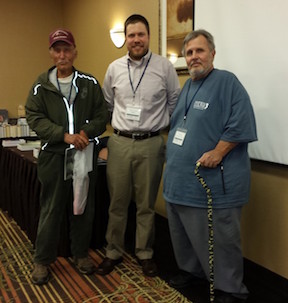An Interview with Ted Alexander (part four)

After a thirty-year career as a historian at Antietam National Battlefield, Ted Alexander retired at the beginning of this year. Just before he left the Park Service, I sat down with him to talk about his career.
CHRIS: Is there a particular story that jumps out at you as a highlight from your career?
TED: Nothing in particular jumps out at me—they’ve all been cool highlights. I think of the late, great Jay Luvass, a military and Civil War historian who would come here frequently with staff rides, for the Army War College in Carlisle, and I remember sitting with him. He’d have his group in the theater, and they’d be watching the movie, perhaps, and he’d sit and have a cup of coffee in our break room. And he’d sit and talk. I have fond memories of that. He and General Harold Nelson—he’s retired, U.S. army, retired. I think those were enriching.
Sitting around with the late, great Joe Harsh. These people left us too soon. Aw. That’s a treasured moment, sitting around with Joe Harsh. He was a regular guy. Just a regular guy, but an intellectual. I have great memories with him.
A lot of great historians like that. Lance Herdegen, the Iron Brigade specialist, for example.
CHRIS: It must have been cool to be here for the Sesquicentennial.
TED: Oh, yeah.
It’s been kind of neat because I was here as a kid for the Centennial. I got to see the last major reenactment on Park Service property. And then I got to be here for the 125th, and along with Paul Childs, the two of us pretty much planned and directed the 125th. And then I was here for the 150th. So that’s kinda cool. (He laughs.)
CHRIS: Is there a particular part of the park’s story that you like?
TED: I like all of it, but I like the story of the civilians. I’ve had the pleasure of helping a number of historians research the civilians. Kathleen Ernst has one of the best books out, and I did the intro for that. John Schildt has done a number of good books on the civilians. I also like things involving the aftermath of Antietam. The battle of Shepherdstown. Jeb Stuart’s Chambersburg raid, which I count as a kind of adjunct to the campaign. So I like that.
I’ve always been interested in some lesser-known facets of the battlefield. I’ve given tours, “Antietam: Off the Beaten Path,” which takes people out around, not on the battlefield, but we’ll go see rare monuments, like the 1st Ohio Light Artillery, which is on Burnside Bridge Road. Nobody sees it ’cause it’s not on the tour. It’s a mile or two off.
You’ve got one of my favorite monuments, and you used to be able to drive by it when I was a kid, is the 15th Massachusetts. That’s the wounded lion. It’s out on Maryland Route 65. It used to be part of the battlefield, but it’s on the edge of the battlefield now because of that bypass, which was built in 1965. But when I was a kid, you drive right by it. That’s to me the most beautiful monument on the field, and it’s a poignant story. They lose half their men, killed and wounded, in about 15 minutes in the West Woods action.
But I’ve always been interested also in the kinda mini-actions within the battle, and one of those, I had a talk, a tour, at one time called “Forlorn Hopes.” It was the attack of Greene’s Division. He was short one brigade, Goodrich, but he had probably 17-hundred men, and got separated from the rest of his command and he attacked and actually penetrated into the West Woods, behind the Dunker Church, and was just kind of hanging there for several hours ‘til the Confederates drove him out. He didn’t have any support, and he ran out of ammunition, so he was pushed out of there, right after noon. I like that story. It’s one of my favorites.
Something else—this may sound a little silly—I like the stories of mascots. I’ve given talks on that. For example, there was one Union regiment on the field, the 11th PA, that had a mascot. Sallie, the dog. The Troup Artillery of Georgia was set up around the Dunker Church, and they had a little white terrier named Charlie. Then the 4th Texas had a dog named Candy. It was a little terrier, and it was presented to them by an Austin candy store owner, and so they called him “Candy.” It was captured in The Cornfield.
One of the more dramatic—and I’m a dog lover, anyway, so I like these—one of the more dramatic stories is there was this officer in the Iron Brigade who had a Newfoundland dog, and he had trained it to do all these special things: stand at attention, don’t ask me how he did it. This officer, Captain Bachelle, he was killed—was mortally wounded and was lying down in the middle of the Hagerstown Pike, not too far, just adjacent to The Cornfield. And after the battle, they found the dog also dead draped across his body. That’s one of the most dramatic cases of canine fidelity here.
So I like those. The 10th Maine had a dog here. They called it “Major.”
So that’s some of the human interest that I like.
Tomorrow, we’ll wrap up ECW’s conversation with Ted Alexander, who’ll look back at changes in the history profession during his thirty-year tenure.